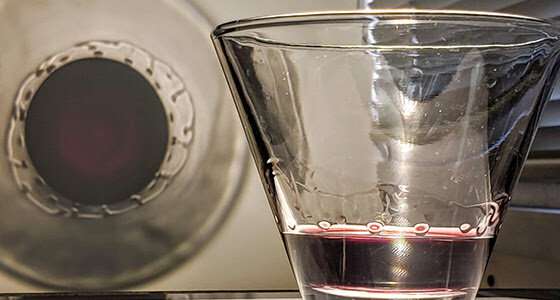March 11, 2020 report
Undercompressive shocks proposed to explain 'tears of wine' phenomenon

A small team of researchers at the University of California has developed a theory to explain the shape of tears of wine. They have written a paper describing their theory and uploaded it to the arXiv preprint server—it has been accepted for publication in the journal Physical Review Fluids.
Tears of wine, in which some of the wine in a glass is pulled up the sides and then drains back down into the remaining wine, are a common occurrence. The resulting patterns that encircle the glass bear a resemblance to human tears. Scientists have been pondering the effect for over a century, and their research has partially explained the process, but there was one remaining mystery—why did the liquid form tear -shaped patterns? In this new effort, the researchers have proposed what they believe is the answer.
Prior study showed that the wine is pulled up the side of the glass by capillary action due to surface tension. As the wine coats the glass surface, it begins to evaporate, but alcohol evaporates faster than the water, making the fluid less alcoholic. And that leads to more surface tension, which pulls the fluid even higher. At some point, the fluid is overcome by gravity, which forces it back down into the glass. This whole process has come to be known as the Marangoni effect, after Carlo Marangoni, who studied the process and published his ideas back in 1865. What remained unknown is why the fluid forms as tear shapes.
To explain the shapes, the researchers studied the effect under a host of settings, and developed a theory. They suggest that shockwave theory provides the answer. They note that shockwaves can form when disturbances occur even when they are not at supersonic speeds. Examples have been observed when evaporation forces a fluid to flow. Under such circumstances, the shockwaves are called undercompressive shocks. The researchers suggest that in the absence of such shockwaves, the wine would form in the shape of fingers. They further suggest the shape is altered by instability in the liquid, leading to shockwaves which result in reverse undercompressive shocks and ultimately, tear-shaped patterns clinging to the side of a glass.
More information: Theory for undercompressive shocks in tears of wine, Physical Review Fluids (2020) journals.aps.org/prfluids/acce … c39536c10099b7209059 , On Arxiv: arxiv.org/abs/1909.09898
Journal information: arXiv
© 2020 Science X Network




















